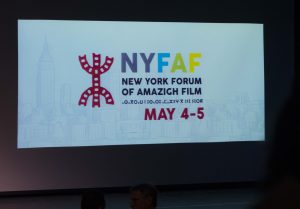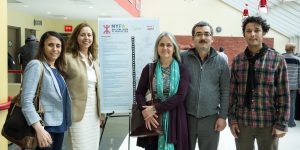Summary:
In 2015 the LaGuardia Performing Arts Center, part of a dynamic community college situated in the cultural crossway of Queens, New York, embarked on a year-long creative and critical examination of Muslim identities titled “Beyond Sacred.” Funded by the Doris Duke Foundation as a response to continuing discrimination and cultural ignorance concerning Muslims in the United States before and after the attacks of 9/11 and the U.S.-led wars in Afghanistan and Iraq, this effort to evoke the vast world of Islam through the lens of diversity hosted a plethora of community discussions, scholarly panels, and an award winning community-based theater piece by the same name directed by Ping Chong. Within this context, Dr. Habiba Boumlik, a Moroccan-born and Amazigh-heritage anthropologist and language expert at LaGuardia Community College, proposed an event to highlight the cultures of North Africa. Working together with Lucy McNair, a translator of North African francophone literature and English professor, Dr Boumlik created the first edition of a New York-based film festival focused on Berbers or Imazighen, the indigenous inhabitants of North Africa.

Our endeavor took two main directions: to model a pedagogical practice of approaching cultural and linguistic diversity through film and discussion, and to inaugurate an open-minded search for Amazigh cinema. Within a contemporary transnational context of exchange and production we wondered what evidence we would find of visual narratives and creative reinscriptions by filmmakers who understood themselves as artists and members of this historically underrepresented and oppressed, yet powerfully resistant and vibrant culture. Secondly, we sought to present the work without falling into a folkloric or essentializing optic. We had no intention to romanticize Berber reality. And thirdly, we targeted a dual audience of multiethnic, multilingual American and immigrant students with little knowledge of North Africa, as well as North Africans living in the diaspora. Was there some way, we wondered, to find Amazigh cinema together?
Trying to avoid bias or premature closure, we choose to open the festival to all possible formats – shorts, documentaries, and feature films. We found it useful to suspend ideological or aesthetic criteria in order to first see and hear what is being developed and produced across the entire expanse of Amazigh space – from the Canary Islands in the Atlantic Ocean to the oasis of Siwa in Egypt. And we strove to allow our audience to interact directly with filmmakers, artists, writers, and scholars, inviting a range of voices to join our Calls for Discussion and our pre and post-screening Q & As. Thus fluidity was reflected in our programs and in the kinds of debates and conversations that ensued.
Taking place between our second and third editions, the Symposium on Transnational Moroccan Cinema or “Moroccan Cinema Uncut” was a timely and huge valuable invitation to connect our local pedagogical concerns with a regional and international perspective on film history and production. We were led to reflect on our endeavor on several levels – practical, theoretical, historical, and aesthetic. As made clear during our Roundtable, the major issue facing Amazigh cinema is language. How does the complex linguistic context impact cinematic narrative, funding, and audience reception of what we are beginning to see as Amazigh cinema? Another concern is the confrontation between oral and visual narratives or syntaxes, especially between spoken language/oral literature and historical texts/footage. How does this second concern become a staging ground for both artistic vision and political statement?
These issues came to inform and enliven our latest edition where we took on a new identity, underscored in Dr. Boumlik’s introductory remarks:
We conceive of our endeavor as a forum or asmgraw in the Amazigh idiolect of Southern Morocco and other parts of Tamazhra, the land of Imazighen. If the choice of words testifies to our project en devenir (in the making), it also aspires to tell a story as it unfolds and sometimes takes us to unforeseen and unexpected routes. Doesn’t the word forum imply uncertainty for the very fact that it is an open platform? We claim a space where free spirits thrive, new talent can be expressed, and new voices can emerge. Our Asmgraw is a forum that reclaims tolerance in a world that is becoming increasingly intolerant. Marginality, minority status, and subaltern identity are just a few forms of expression often associated with the Imazighen.
Working together with a wider group of collaborators and an enlarged budget, we were especially intent to reach out to new talents in the Canary Islands, the Egyptian Oasis of Siwa, and the Imazighen of Libya, as well as continue to the history and contribution of Jewish communities, all stakeholders in the ancient history of North African and Amazigh identity. We invited Ahmed Baidou from Morocco and Pablo Rodriguez from the Canary Islands to present new work that used and reconstituted Tamazight as a basis for dramatic dialogue, imaginative engagement with the recorded and the ancient pasts, and artistic response to current political debates on identity in their national spheres. And we consolidated our endeavor in a mission statement:

NYFAF is an asmagraw or open space where filmmakers, scholars, writers, translators, and musicians, whose work focuses on Amazigh identity and culture, can share their knowledge and enthusiasm with a diverse audience. Through a free forum of shorts, documentaries, and feature films by and about the indigenous societies of North Africa, stretching from the Canary Islands in the Atlantic Ocean to the oasis of Siwa in Egypt, as well as scholarly discussions, Q&As with filmmakers, musical performance, and exhibition of cultural artifacts, NYFAF seeks to disseminate and encourage Amazigh cinema and to celebrate the history, culture, and language of Amazigh peoples across North Africa and in the diaspora.
In our contribution to the collection we will review the path we have taken so far, the emergent body of films we have discovered and shown, the reception they have received at home and in our Forum, and the constructive comments from the Roundtable. We will then turn to our goals and challenges as we move ahead. We invite your comments and suggestions.